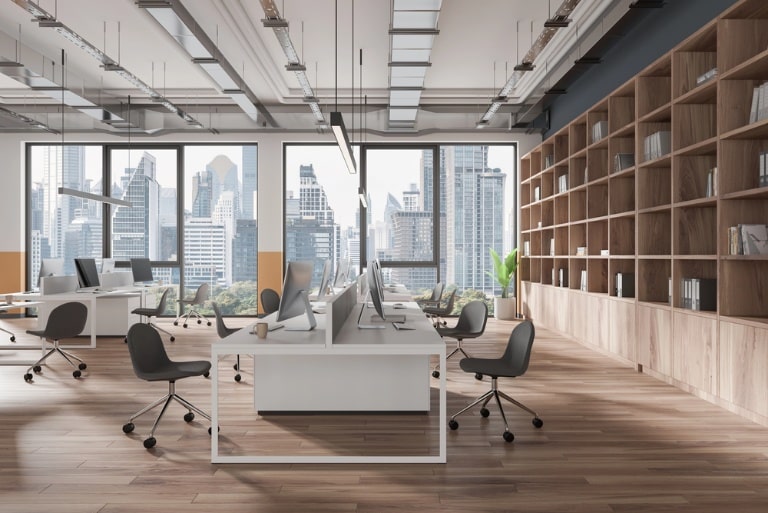From Public Safety to Profit: How Efficient Spaces Drive Business Success?

In today’s highly competitive business world, the design and management of your business space are integral to both employee performance and customer satisfaction. Whether it’s an office, retail store, hotel, or any other commercial space, how you design your facilities can have a profound impact on your bottom line.
An efficient, well-thought-out space can help reduce costs, increase employee productivity, and significantly enhance the customer experience—all of which contribute to long-term profitability. This article explores the key design strategies that will drive business success through efficient spaces.
The Link Between Space Design and Profitability
Business premises are more than just a place to work or sell products—they represent your brand, values, and commitment to your employees and customers. A well-designed space can make a significant difference in the overall success of the business.
When designing your facility, consider how the layout, functionality, and aesthetics influence employee efficiency and customer engagement. Research shows that businesses that invest in optimizing their physical environments see tangible benefits, from increased customer retention to improved employee satisfaction.
Efficient space design isn’t just about aesthetics—it’s about creating an environment where both employees and customers feel valued, comfortable, and empowered to perform their best. A thoughtfully designed space encourages productivity, enhances the customer experience, and ultimately drives profitability.
Optimize Layout for Workflow and Efficiency
When it comes to efficiency, layout is key. An optimized layout ensures that your space supports seamless operations, minimizes wasted time, and maximizes employee productivity. In commercial spaces, the workflow should be designed to reduce bottlenecks, improve movement, and facilitate smooth interactions.
Ergonomics and Layout Design
In offices or workspaces, ergonomics plays a crucial role in improving employee well-being and productivity. Workstations should be designed to support comfort and reduce physical strain. Providing ergonomic furniture like adjustable chairs and sit-stand desks will allow employees to work more comfortably and effectively throughout the day.
Flexible and Collaborative Spaces
A successful workspace balances open, collaborative spaces with private areas for focused work. Open-plan spaces foster communication and teamwork, but employees also need quiet zones to concentrate on tasks. Designing flexible spaces that can be adapted as needed allows businesses to accommodate future growth and changing needs without additional costs.
Flow and Accessibility
In retail and public spaces, ensuring that customers can easily navigate through the space is essential. Well-thought-out layouts reduce friction, making it easier for customers to find what they’re looking for, improving their overall experience and increasing the likelihood of a sale.
Incorporate Technology for Streamlined Operations
Technology plays a significant role in making business spaces more efficient and productive. Integrating smart technologies into your space can streamline operations, reduce costs, and enhance the experience for both employees and customers.
Smart Office Solutions
Incorporating smart office technologies, such as automated lighting and temperature control systems, can help reduce utility costs while creating a more comfortable work environment. Additionally, systems like automated inventory management and digital signage can help optimize store and warehouse layouts, improving efficiency.
Point-of-Sale Systems and Customer Interactions
For businesses that interact directly with customers, having an integrated point-of-sale (POS) system can streamline transactions, reduce human error, and speed up the buying process. This improves customer satisfaction and frees up time for employees to focus on more important tasks, such as customer service or restocking.
Focus on Employee Well-Being and Comfort
A crucial part of running an efficient business is ensuring that your employees are comfortable and motivated. Employee well-being directly influences productivity and retention. Designing workspaces that prioritize comfort, safety, and health leads to better work outcomes and a more positive atmosphere.
Ergonomics and Comfort
Investing in ergonomic furniture and providing well-designed workstations leads to reduced physical strain, fewer injuries, and higher productivity. Comfortable chairs, proper desk heights, and adjustable standing desks help employees stay comfortable and focused throughout the day.
Natural Light and Ventilation
Natural light improves mood, focus, and overall well-being, so it’s important to design spaces with ample natural light. Additionally, good air quality and ventilation systems are essential to maintaining a comfortable and healthy work environment.
Break Areas for Relaxation
Break areas are crucial for employee relaxation. Offering comfortable and accessible spaces for employees to recharge helps reduce stress and fatigue, making them more productive and happy in the long run.
Enhance Customer Experience Through Design
Customer experience is at the heart of any successful business. The physical design of your premises directly influences how customers feel about your brand and their overall experience. A well-designed space can make customers feel welcome, valued, and eager to return.
Wayfinding and Signage
Clear and intuitive signage helps customers navigate through your space with ease, reducing confusion and frustration. Whether it’s in a hotel, retail store, or office, good signage ensures that customers can find their way to the areas they need.
Comfort and Aesthetics
Design elements such as seating, temperature control, and lighting contribute significantly to the atmosphere of a space. A comfortable environment encourages customers to stay longer and engage more with your brand.
Privacy and Hygiene
In public spaces like restrooms or healthcare settings, ensuring privacy and hygiene is essential for customer comfort. For example, replacing any compromised bathroom partition helps improve privacy and cleanliness, creating a more comfortable and professional environment for your customers.
Incorporating Sustainable and Cost-Effective Design
Sustainability isn’t just good for the environment—it’s also good for your bottom line. Sustainable business practices, including the use of energy-efficient lighting, eco-friendly materials, and water-saving fixtures, can help businesses reduce operational costs in the long term.
Energy-Efficient Design
LED lighting, energy-efficient HVAC systems, and insulated windows can drastically reduce utility bills. These changes may have an upfront cost but lead to substantial savings over time, increasing overall profitability.
Sustainable Materials
Using sustainable, low-maintenance materials for furniture and fixtures helps minimize future costs related to repairs or replacements. These materials are often more durable, long-lasting, and cost-effective in the long run.
Conclusion
Designing an efficient business space is not just about creating an aesthetically pleasing environment—it’s about improving functionality, reducing costs, and driving profitability. By optimizing layout, incorporating technology, focusing on employee well-being, and enhancing the customer experience, businesses can create a space that fosters growth and success.
Efficient, well-designed spaces contribute to employee satisfaction, customer loyalty, and long-term profitability. Whether it’s through strategic layout choices, technological integration, or thoughtful investments like bathroom partitions for better privacy and comfort, businesses can leverage design to optimize performance and drive success.
Investing in efficient space design is more than a design choice—it’s a business strategy that pays off in higher productivity, customer retention, and a healthier bottom line.




